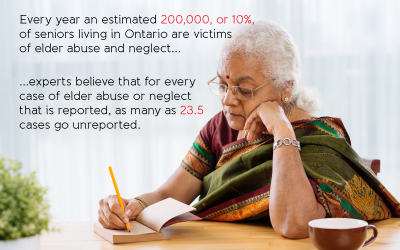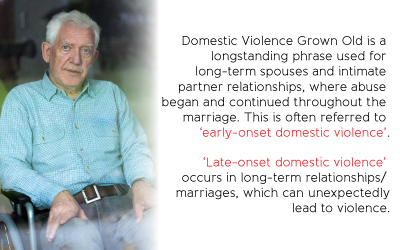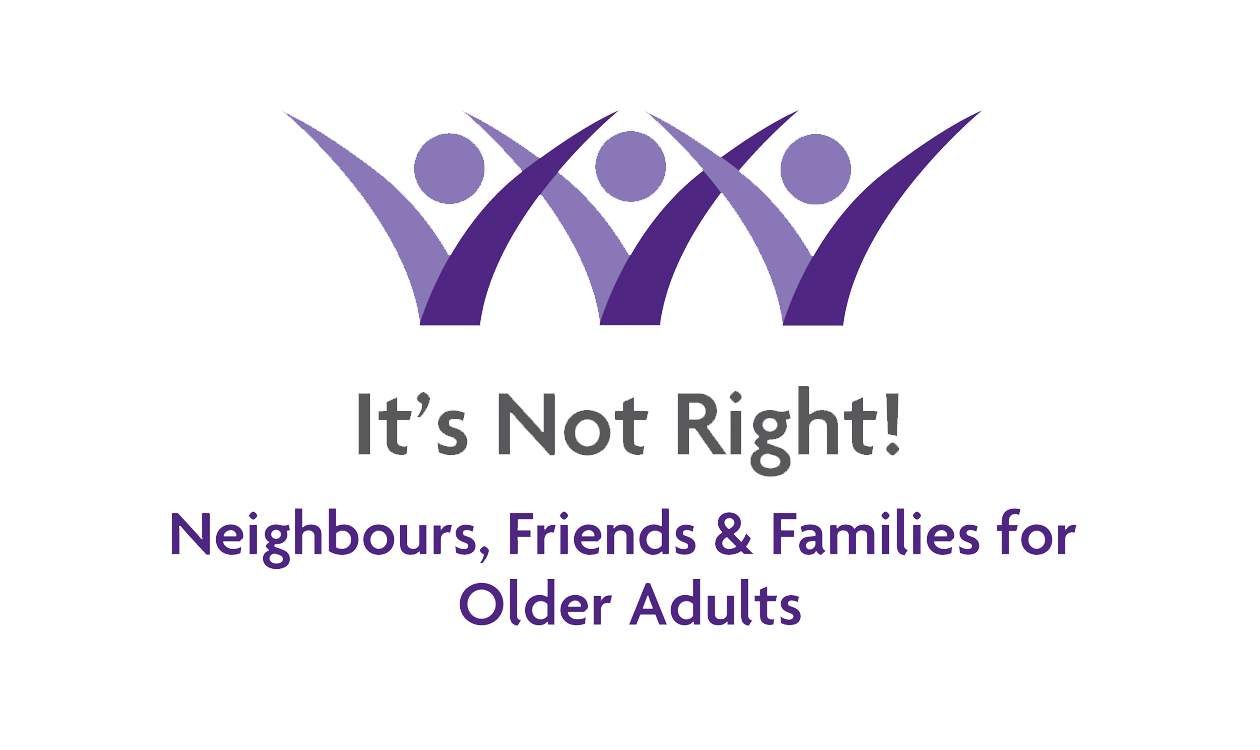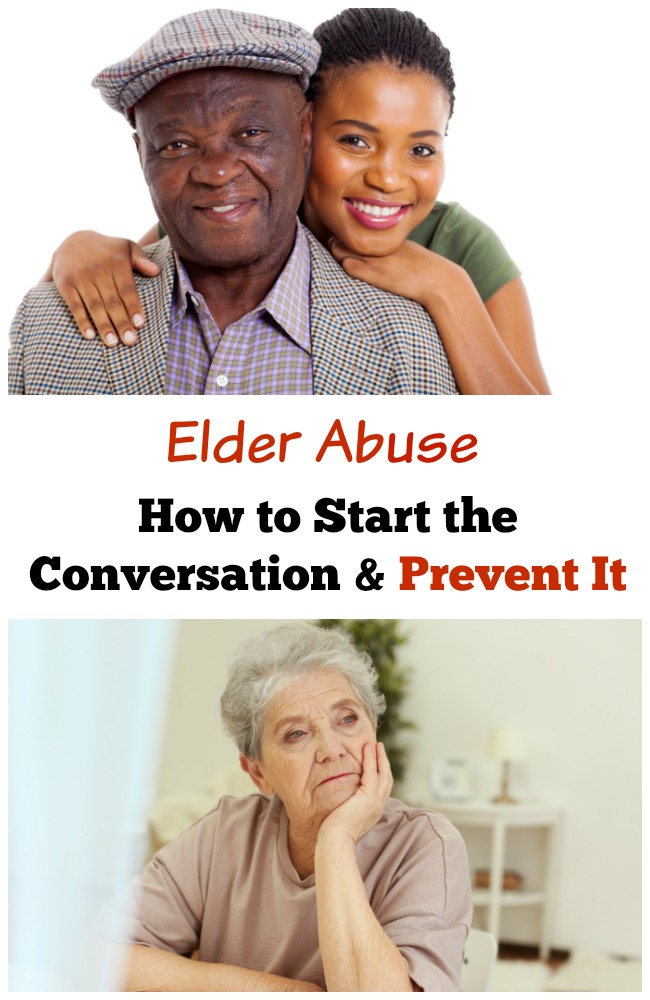Starting the Conversation... Domestic Violence in Later Life

Raeann Rideout, M.A.
Raeann Rideout is currently the Central East, Regional Elder Abuse Consultant for Elder Abuse Ontario (EAO). In this role, Ms. Rideout has responsibility for implementing Ontario’s Strategy to Combat Elder Abuse. She 19 years of experience working in the field of elder abuse that includes, delivering training to front-line service providers; providing public education to older adults; and facilitating collaboration between community organizations, justice services, government, and senior organizations at local, provincial and national levels to enhance to enhance the response older adult’s at-risk or experiencing abuse.
Raeann is also the Co-chair of the Canadian Network for the Prevention of Elder Abuse.
Domestic violence does not just affect younger people. It affects all cultures, religions, races, sexual orientations and every age, including older adults.
Often we don’t think that someone, especially a family member, would violently assault or harm an aging parent or loved one. Unfortunately, the abuse of older adults continues and is often at the hands of a spouse or family member, leaving the person to live in fear, silently suffering behind closed doors.
What is Family Violence?
Family violence occurs when someone engages in abusive behaviour to control and/or harm a member of their family or someone with whom they have an intimate relationship. It may include many different forms of abuse, ranging from physical and emotional to neglect being carried out (Dept. of Justice Canada, 2016) 1. Those experiencing domestic abuse in later life also have an on-going relationship with the abuser who is a ‘trusted’ individual, including a spouse or partner, family member, and/or caregiver.
In Canada, the percentage of seniors in the population (16.9 per cent) currently exceeds the share of children (16.6 per cent). 2 At the same time that the population is growing, the likelihood of more domestic abuse occurring in the future increases. 3 Every year an estimated 200,000, or 10%, of seniors living in Ontario are victims of elder abuse and neglect. And that’s only part of the picture: experts believe that for every case of elder abuse or neglect that is reported, as many as 23.5 cases go unreported. 4 Those working in the justice sector as well as health care professionals are increasingly dealing with more and more cases of domestic violence, more so now than in the past.

Facts:
- Over 766,000 or 8% of Canadians over the age of 55 years said they had experienced abuse or neglect in the previous year. 5
- Out of the 4 in 10 seniors experiencing family violence, the acts are committed primarily by their grown children (43%) and spouses (28%) 6.
- Spousal violence for senior women was nearly double that of senior men 7
- Family violence can have a significant negative impact on the health and well-being of the older adult.
How is Elder Abuse Different?
The complexities of domestic violence in later life differ from those towards younger people, particularly in the tactics used to take control of the older adult. An older adult’s vulnerability to abuse increases if there is dependency for care or if there are cognitive impairments due to stroke, dementia and/or physical disabilities that render them unable to protect themselves.
They may also encounter significant barriers that inhibit their ability to seek help or report the abuse to authorities. When an older adult’s own son or daughter is the person causing them harm - the same person whom they nurtured and raised through life - they find it extremely difficult to tell anyone what is happening.
There are overwhelming issues and fears such as: losing that family member in their life – often choosing to live with the abuse. The emotional anxiety of being rejected by other family members or the fear of starting over with little or no financial resources to do so, are all very real challenges and considerations for the older adult. Having to worry about housing or about being placed into a long-term care home, or not having knowledge about community supports and what will happen if reported or whether rights can be taken away or not. 6,7
Domestic violence may take on different forms at various stages in a person’s later life.
The term Domestic Violence Grown Old is a longstanding phrase used for long-term spouses and intimate partner relationships, where abuse began and continued throughout the marriage. This is often referred to ‘early-onset domestic violence’.
‘Late-onset domestic violence’ occurs in long-term relationships/ marriages, which can unexpectedly lead to violence, perhaps triggered by an event or significant life change. Examples of such changes are: retirement, disability or having to care for the spouse in failing health. In addition, late onset violence may also be attributed to cognitive impairments common in aging, like those brought on by stroke, Alzheimer’s Disease or substance abuse (alcoholism), causing aggressive and violent behaviors in otherwise ordinary, respectful marriages. 8

Shelters are seeing an influx of older women seeking services and assistance after experiencing domestic violence.
It’s Not Right!
Starting the Conversation to Stop the Abuse of Older Adults
 Elder Abuse Ontario is partnering with Western University and the Ministry of Seniors Affairs to create a movement of social change in Ontario to stop abuse and neglect of older adults. The It’s Not Right! Neighbours, Friends and Families for Older Adults (INR) campaign is being implemented across the province.
Elder Abuse Ontario is partnering with Western University and the Ministry of Seniors Affairs to create a movement of social change in Ontario to stop abuse and neglect of older adults. The It’s Not Right! Neighbours, Friends and Families for Older Adults (INR) campaign is being implemented across the province.
Research has shown that most often it is bystanders – neighbours, friends, family and co-workers – who are closest to abusive situations and can see what is happening. They know that something isn’t right, but don’t know what to do.
There are over 170 INR Champions across Ontario who are available to provide educational sessions on elder abuse! They engage people in discussions and practice on how neighbours, friends and family members can learn to recognize and respond to warning signs of abuse and neglect in the lives of older adults they know and how to respond safely and effectively.
June is Senior’s Month, a time to recognize seniors in our communities. On June 15, 2017 we celebrate World Elder Abuse Awareness Day (WEAAD) to create awareness of elder abuse and engage community members to Start the Conversation and promote dignity and respect of older adults.
WEAAD serves as a call-to-action for individuals, organizations, and communities to raise awareness about abuse and neglect of seniors. The International Network for the Prevention of Elder Abuse and the World Health Organization at the United Nations (UN) launched the first World Elder Abuse Awareness Day on June 15, 2006 in an effort to unite communities around the world in raising awareness about elder abuse.
Elder Abuse Ontario encourages individuals and organizations to take action on WEAAD – to plan an event, activity or book an educational It’s Not Right session to heighten awareness that elder abuse is a serious issue that must be addressed and taken seriously.
We all have a vital role to play in creating a peaceful, supportive and just society. Learn about the little things YOU can do to make a BIG difference in someone’s life.

Join us on June 15th to Start the Conversation to Stop the Abuse of Older Adults!
If you are interested in having a Champion speak to your agency or senior group/club or attend an event, please contact Elder Abuse Ontario via email: admin@elderabuseontario.com or phone: 416.916.6728.
Seniors Safety Line 1-866-299-1011
References
2 Census Profile, 2016 Census
3 Sev'er, A. 2009. "More than wife abuse that has gone old: A conceptual model for violence against the aged in Canada and the US. Journal of Comparative Family Studies. Spring.Vol.40,no.2. p.279-292.
4; Lifespan of Greater Rochester, Inc., Weill Cornell Medical Center of Cornell University, & New York City Department for the Aging. (2011). Under the Radar: New York State Elder Abuse Prevalence Study (PDF).
5 McDonald, L., Beaulieu, M., Goergen, T., Lowenstein, A., Thomas, C., Lombardo, A., Bergeron-Plateaued, J. & Kay, T. (2016). Into the light: national survey on the mistreatment of older Canadians 2015. (National Initiative for the Care of the Elderly).
6,7 Family Violence in Canada: A statistical profile , 2013 (Section Family violence against seniors.
8 And Then He Hit Me David France, January & February 2006

